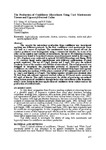Artificial Seed Production from Encapsulated Microshoots of Cauliflower (Brassica oleraceae var botrytis)
| dc.contributor.author | Rihan, Hail | |
| dc.contributor.author | Fuller, MP | |
| dc.contributor.author | Al-Issawi, M | |
| dc.contributor.author | Burchett, S | |
| dc.contributor.editor | Rihan HZ | |
| dc.contributor.editor | Al-Shamari M | |
| dc.contributor.editor | Al-Issawi M | |
| dc.contributor.editor | Fuller MP | |
| dc.date.accessioned | 2013-01-28T14:00:40Z | |
| dc.date.available | 2013-01-28T14:00:40Z | |
| dc.date.issued | 2012-10 | |
| dc.identifier.issn | 0567-7572 | |
| dc.identifier.issn | 2406-6168 | |
| dc.identifier.uri | http://hdl.handle.net/10026.1/1264 | |
| dc.description.abstract |
A cost effective protocol for the production of cauliflower microshoots suitable for encapsulation was designed. Microshoots were encapsulated in sodium chloride matrices. The use of 2% of sodium alginate and 15 g/L of dehydrate calcium chloride produced the optimal quality of artificial seeds (rigidity, conversion rate and viability). Of the various plant growth regulator combinations used with the microshoot liquid culture medium, the use of 1 mg/L of IBA (indole butyric acid) and 1 mg/L Kinetin was found to be optimal in terms of the conversion rate and viability of artificial seeds. To standardize a medium composition of artificial endosperm of synthetic seeds, different concentrations and combinations of plant growth regulators with S23 (4.4 MS + 30 g/L sucrose) medium were used in the beads to achieve optimum conversion rate and viability on an in-vitro medium. Whilst several combinations of plant growth regulators gave a conversion rate up to 100% (for example (0.5 mg/L Kinetin + 0.5 mg/L IBA), (1 mg/L Kinetin + 0.5 mg/L NAA (naphthaleneacetic acid)) and (1 mg/L Kinetin + 1 mg/L IAA (indole-3-acetic acid)), no significant effect on the viability of artificial seeds was found when these combinations were used. Artificial seeds were cultivated in a semi-solid medium containing several types and concentrations of auxin, 2 mg/L of IBA gave the best results in terms of artificial seed viability. However, artificial seed conversion rate was not significantly affected by the auxins and full conversion rate was obtained using many different treatments. This research indicated the feasibility of using artificial seeds as a promising alternative to seeds produced by traditional methodology. | |
| dc.format.extent | 419-425 | |
| dc.language.iso | en | |
| dc.publisher | International Society for Horticultural Science (ISHS) | |
| dc.subject | sodium alginate | |
| dc.subject | plant growth regulators | |
| dc.subject | meristematic tissue | |
| dc.subject | curd | |
| dc.subject | calcium chloride | |
| dc.title | Artificial Seed Production from Encapsulated Microshoots of Cauliflower (Brassica oleraceae var botrytis) | |
| dc.type | journal-article | |
| dc.type | Article | |
| plymouth.author-url | https://www.webofscience.com/api/gateway?GWVersion=2&SrcApp=PARTNER_APP&SrcAuth=LinksAMR&KeyUT=WOS:000323607700055&DestLinkType=FullRecord&DestApp=ALL_WOS&UsrCustomerID=11bb513d99f797142bcfeffcc58ea008 | |
| plymouth.issue | 961 | |
| plymouth.volume | 961 | |
| plymouth.publication-status | Published | |
| plymouth.journal | Acta Horticulturae | |
| dc.identifier.doi | 10.17660/actahortic.2012.961.55 | |
| plymouth.organisational-group | /Plymouth | |
| plymouth.organisational-group | /Plymouth/Faculty of Science and Engineering | |
| plymouth.organisational-group | /Plymouth/Faculty of Science and Engineering/School of Biological and Marine Sciences | |
| plymouth.organisational-group | /Plymouth/REF 2021 Researchers by UoA | |
| plymouth.organisational-group | /Plymouth/REF 2021 Researchers by UoA/UoA06 Agriculture, Veterinary and Food Science | |
| plymouth.organisational-group | /Plymouth/Users by role | |
| plymouth.organisational-group | /Plymouth/Users by role/Academics | |
| dc.identifier.eissn | 2406-6168 | |
| dc.rights.embargoperiod | Not known | |
| rioxxterms.versionofrecord | 10.17660/actahortic.2012.961.55 | |
| rioxxterms.licenseref.uri | http://www.rioxx.net/licenses/all-rights-reserved | |
| rioxxterms.type | Journal Article/Review |


